The neutron star is the superdense remains of a massive star that has collapsed with sufficient force to push all of its electrons into the nuclei that they orbit — The American Heritage® Dictionary
A neutron star is a type of remnant that can result from the gravitational collapse of a massive star during a Type II, Type Ib or Type Ic supernova event. Such stars are composed almost entirely of neutrons, which are subatomic particles with zero electrical charge — Wikipedia
Pulsars are highly magnetized, rotating neutron stars that emit a beam of electromagnetic radiation...Werner Becker of the Max Planck Institute for Extraterrestrial Physics said in 2006, "The theory of how pulsars emit their radiation is still in its infancy, even after nearly forty years of work." — Wikipedia
» Neutron - An electrically neutral subatomic particle in the baryon family, having a mass 1,839 times that of the electron, stable when bound in an atomic nucleus, and having a mean lifetime of approximately 1.0 x  seconds as a free particle. It and the proton form nearly the entire mass of atomic nuclei and as such, make up most of the mass of the visible matter in the universe.
seconds as a free particle. It and the proton form nearly the entire mass of atomic nuclei and as such, make up most of the mass of the visible matter in the universe.
» Pulsar - a neutron star which emits beams of radiation that sweep through the earth's line of sight. The term pulsar is an abbreviation for pulsating radio star or rapidly pulsating radio sources. Like a black hole, it is an endpoint to stellar evolution. The "pulses" of high-energy radiation we see from a pulsar are due to a misalignment of the neutron star's rotation axis and its magnetic axis. Pulsars pulse because the rotation of the neutron star causes the radiation generated within the magnetic field to sweep in and out of our line of sight with a regular period. [1]
» Neutron Star - Neutrons were discovered in 1932 and very shortly afterward (in 1934) a suggestion was made by Walter Baade and Fritz Zwicky that neutron stars were formed in supernovae. Neutron stars were proven to exist when in 1967 Jocelyn Bell, working on radio observations of quasars, found the radio emissions of pulsar CP 1919. It was quickly thereafter determined that the source was a highly rotating neutron star. [2]
» Jocelyn Bell Burnell - discovered the first radio pulsars in 1967; Ph.D. in radio astronomy from Cambridge University in 1968. For a short bibliography and interview see the StarChild website page entitled Jocelyn Bell Burnell
» Crab Pulsar - a much-studied supernova remnant containing a neutron star. For additional information on the Crab Pulsar see Wikipedia & the National Radio Astronomy Observatory The Crab Pulsar and Nebula
» Solar Mass - The solar mass (M ), 1.98892 x 1030 kg, is a standard way to express mass in astronomy, used to describe the masses of other stars and galaxies. It is equal to the mass of the Sun, about two nonillion kilograms or about 332,950 times the mass of the Earth or 1,048 times the mass of Jupiter. For additional information on soalr mass see Wikipedia
), 1.98892 x 1030 kg, is a standard way to express mass in astronomy, used to describe the masses of other stars and galaxies. It is equal to the mass of the Sun, about two nonillion kilograms or about 332,950 times the mass of the Earth or 1,048 times the mass of Jupiter. For additional information on soalr mass see Wikipedia
» Density - measured in grams per cubic centimeter (or kilograms per liter): the density of water is 1.0; iron is 7.9; lead is 11.3. A typical neutron star has a mass between 1.4 and 5 times that of the Sun. It cannot be more massive than this or gravity will overwhelm it and it will become a black hole! The radius of a neutron star may be between 10 and 20 kilometers. [3] The surface and core density of a neutron star has often been stated via anology — a teaspoon full of it's core material would weigh between a billion and ten billion tonnes; it's surface material would weigh a million tonnes plus.
» Gravitational Collapse - is ( for purposes of this section ) the implosion of a star or other stellar object under the influence of its own gravity. The resulting object is many times smaller and denser than the original body from which it was formed.
» Implosion - in a star, implosion is the result caused by the sudden stop of it's fusion process thereby causing a violent collapse inward of it's layers towards the iron core.
» The Chandrasekhar limit - is a law which sets the maximum limit possible for a nonrotating mass which can be supported against gravitational collapse by electron degeneracy pressure. It was named after Subrahmanyan Chandrasekhar, shared winner of the 1983 Nobel Prize in physics for his work on the theory of white dwarf stars. For additional reference see Chandrasekhar limit at the Free Dictionary website.
» Electron Degeneracy Pressure - Electron degeneracy pressure is a consequence of the Pauli exclusion principle, which states that two fermions cannot occupy the same quantum state at the same time. The force provided by this pressure sets a limit on how much matter can be squeezed together without it collapsing into a neutron star or black hole. It is an important factor in stellar physics because it is responsible for the existence of white dwarfs. For additional reference see Wikipedia
» Type II, Type Ib or Type Ic Supernova - also called core-collapse supernovas. A star is formed of layers of different elements with the outer layers of hydrogen, helium, carbon, and silicon burning around an iron core, building it up. Eventually, the massive iron core succumbs to gravity and it collapses to form a neutron star. The outer layers of the star fall in and bounce off the neutron core which creates a shock wave that blows the outer layer outward. This is the supernova explosion. [4]
» Black Hole - an area of space-time with a gravitational field so intense that its escape velocity is equal to or exceeds the speed of light. For additional study of black holes see Black Hole at the High Energy Astrophysics Science Archive Research Center (HEASARC) which is the data archive repository for extremely energetic phenomena, from black holes to the Big Bang.
» Spin, Rotation & Effects - a neutron's high axial or off-axial spin is based on the law of conservation of momentum. The neutron star, prior to it's supernova demise, rotates at X times per cycle. After it loses it layers, only the core survives, a much small object, and now that same rotation cycle is much reduced , the rate of spin is much increased as a result ( e.g. If a solar-size star with a 100 day spin period collapses into a neutron star, its spin period will become about 1 ms ). The effects: as most young neutron stars are spinning very fast, the strong magnetic fields combined with rapid rotation create an awesome generator that can produce electric potential differences of quadrillions of volts. Such voltages, which are 30 million times greater than those of lightning bolts, create deadly blizzards of high-energy particles. [5]
» Types, Classification - types of neutron stars include: Radio-quiet neutron stars & radio loud neutron stars, Rotation-powered pulsar, Magnetar, Soft gamma repeater, Anomalous X-ray pulsar, Binary pulsars, Low-mass X-ray binaries ( LMXB ), Intermediate-mass X-ray binaries ( IMXB ), High-mass X-ray binaries ( HMXB ), Accretion-powered pulsar ( "X-ray pulsar" ), X-ray burster ( a neutron star with a low mass binary companion from which matter is accreted resulting in irregular bursts of energy from the surface of the neutron star ) and Millisecond pulsar ( MSP ). This list excludes all hypothetical types for which no evidence of their existence is currently ( 2009 ) at hand. For more details on this listing of neutron star types see Wikipedia
NEW ! Starting with this edition, the following "You Should Know" category is introduced:
»
Astronomers, Astrophysicists & Researchers - the following are just a few of the individuals historically associated with the stellar object under study and include professional or amateur astronomers, scientists, astrophysicists and researchers the world over.
Jocelyn Bell Burnell  Fritz Zwicky *
Fritz Zwicky *  Walter Baade *
Walter Baade *  Rudolf Minkowski **
Rudolf Minkowski **  William Parsons
William Parsons 
*
The Columbia Encyclopedia, Sixth Edition. 2008. Encyclopedia.com. 13 May. 2009.
**
The Bruce Medalists by
Joseph S. Tenn Photo of Rudolf Minkowski courtesy Astronomical Society of the Pacific.
2. Neutron Star — Formation
Imploding Star & Exploding Supernova
The Stellar Object, Pre and Post-Formation

The explosive force is the largest known in the universe and as such, the shockwave it creates travels at speeds in excess of 50 million kilometers per hour. At this velocity it slams into and races through the now expanding stellar debris, fusing lighter elements into heavier ones and producing a brilliant visual outburst that can be as intense as the light of several billion Suns. This is a type II supernova and it's caused by the sudden stop and immediate reversal in the process of implosion. What is left — a highly rotating core of dense material called a Neutron Star. Image Credit:
Chandra X-Ray Observatory [6]
But implosion from what and how?
To begin, the neutron star is a product of the process of stellar evolution — from protostar, through red giant to supernova/nebula — this type of star is nearing the end of it's stellar life cycle. Qutoing from our earlier section entitled
Red Giant Stars:
"This star is old, it's age measured in billions of years. The fuel that was once so abundant, hydrogen, is running out. During it's life time the star's own thermonuclear engine has been producing the heavier element helium which is now moving inwards, until only a shell of hydrogen remains around the exterior of the core. As this happens, the star's own gravity begins to shrink this core, causing an increase in tempeture and beginning a period of hydrogen to helium burning with the results that it's outer layers begin to expand greatly..."
Small Mass Stars
What happens next depends on the size or mass of the star as this directly relates to how long it's layers remain and just what elements the star will continue to fuse, a process that causes the material to compress in and on the interior core of the star, causing it to become denser and denser. In stellar evolution a star, like our sun, burns through it's hydrogen supply over billions of years in a process we know as fusion. When this runs out the heavier element helium will ignite as a result of the density around the core having increased, causing the remaining supply of hydrogen to burn even faster and creating even more heat. This heat causes the outer layers of the star to expand away from the hot core, cooling rapaidly as the suface area of the star becomes too great for the energy output of the core to continue heating. At this point the star has become a red giant and red giant stars with an average mass of our sun will only continue to fuse helium to carbon ( the limit of elements it will be hot enough to ignite ) until the helium burning, igniting intermittently, finally stops. That "intermittent" ignition of the helium is what causes the surface layers of the red giant to be blown off and away from the core, creating those cool nebulae images seen at APOD and in text books.


If our star has a solar mass of less than 1.4, called the
Chandrasekhar limit it will eventual collaspe upon itself, stopping when it's electrons, wanting to remain away from it's nuclei, overcome the process of collaspe through a force known as
electron degeneracy pressure, thereby creating a
white dwarf star. On the other hand, a star with mass greater than the Chandrasekhar limit of 1.4 will have far too much pressure from gravity at it's core, causing the electrons to be squeezed right into the protons, creating a core of almost nothing but neutrons. At this point, the star will either have expelled it's outer layers, remaining under the 1.4 mass limit ( this occurs for stars whose orignal mass is around 2-5 ) or else, have literally blown itself apart in an explosion that can be seen across 13 billion light years — the supernova. Click the filmstrip icon at left to view an animation of a supernova explosion (Quicktime format) which dissolves into the Chandra First Light Image of the supernova remnant Cassiopeia A. Credit:
Chandra X-Ray Observatory
Larger Mass Stars
For stars with 10, 100 or even larger masses, something else occurs in the above process — they keep right on burning, fusing heavier and heavier elements, right through to the last element available, the element
iron 56 or

and this is where the process comes to a screeching halt, almost. What has happened up to this point is that all the previous elements that have been ignited have been exhausted, their remains gravtionally compressed towards the core of the star ( remember that a star is held together through the force of it's own gravity ) creating a fantastic amount of pressure upon it, so much so that in some cases enough pressure is built up to ignite even the iron at the core, but this final ignition just speeds up the process of collaspe for, unlike all the other elements, iron 56 requires more engery to fuse than it produces.
Whether the final process ignites the iron 56 or not, the end is still the same for the star. With the thermonuclear fusion now gone the very force that has held the star together, gravity, is also gone. All of the star's material mass, from the core outward, fall or collaspe inward, the
elementary atomic particles becoming more tightly packed together than ever before. What it then comes down to is the initial mass of the star as those with masses higher than 20-30 form a black hole and those with less mass form either a neutron star or white dwarf.
"With the core collapsed, each subsequent layer also collapses inward. But the major effect comes from the fact that in some ways the core behaves like a rubber ball. As the core falls in on itself, electrons and nuclei are squeezed together into neutrons, and even the neutrons are squeezed into each other--but they push back! and the core actually bounces outward. The shockwaves from the collapse and the bounce (both are spherical) meet and reinforce, and the star very rapidly tears itself apart in what is called a Type II Supernova. During the explosion, enough energy is available to fuse iron into all the elements up to uranium and beyond. This matter gets distributed, with at least 80% of the star's original mass, in a huge nebula called a supernova remnant.
If the stellar remnant (really just the core of the former star) is small, it will become a white dwarf or a neutron star. But if the stellar remnant is bigger than 3 solar masses, gravity overcomes everything and the star collapses to nothing! Only the gravity remains! This mighty odd-sounding state of affairs is called a
black hole." [7]
Neutron Star CXO J164710.2-455216



"The optical image (above left) of Westerlund 1 shows a dense cluster of young stars, several with masses of about 40 suns. Some astronomers speculated that repeated collisions between such massive stars in the cluster might have led to formation of an intermediate-mass black hole, more massive than 100 suns. A search of the cluster with Chandra (above) found no evidence for this type of black hole. Instead they found a neutron star (CXO J164710.2-455216), a discovery which may severely limit the range of stellar masses that lead to the formation of stellar black holes. In the image at right, the neutron star - a dense whirling ball of neutrons about 12 miles in diameter - revealed itself through periodic X-ray pulsations (every 10.6 seconds). A neutron star is left behind after a massive star completes its evolution and goes supernova. Since extremely massive stars evolve more rapidly than less massive ones, and the progenitor of the neutron star has already exploded as a supernova, its mass must have been greater than 40 solar masses." Click on the filmstrip icon at right to view a short movie of the Westerlund 1 images from Chandra. Images from the
Chandra X-Ray Observatory, credit: NASA/CXC/UCLA/M.Muno et al. [8]
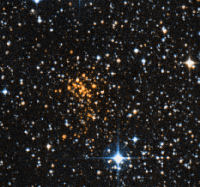

Name: ARA CLUSTER, Open (galactic) Cluster, location is RA: 16 47 04.00 Dec: -45 51 04.9, Galatic Long. & Lat. is 339.5493 -00.4042 with a spectral type of O. It is also known as Cl Westerlund 1, ESO 277-12, C 1644-457 and Cl VDBH 197. Query:
C.D.S. - SIMBAD4 rel 1.121 - 2009.05.11CEST22:26:21 Image:
Aladin Previewer At right is a frame from a visualization showing "a fly-through of Cas A based on the 3-D representation constructed from Chandra and Spitzer data. It begins with an artists rendition of the neutron star previously detected by Chandra. Next, new features unseen in traditional 2-D data sets are visible, including details of how the parent star exploded. The green region is mostly iron observed in X-rays; the yellow region is mostly argon and silicon seen in X-rays, optical and infared; the red region is cooler debris seen in the infared and the blue region is the outer blast wave, most prominent in X-rays." [9]
The Crab Nebula - Supernova
The Crab Pulsar - Neutron Star
Crab Nebula in RGB. Image retrieve from Aladin The Crab Nebula — Supernova Remnant, Rotating Neutron and Pulsar Star
The Crab Nebula — Supernova Remnant, Rotating Neutron and Pulsar StarIt has been one of science's most studied stellar objects, the Simbad object query site lists over 65 unique astronomical identifiers for it and in dozens of intense scientific studies the same conclusion is reached — unsolvable questions regarding the numerous and mysterious filaments that are at odds with the physical properties of supernovae. It's central neutron star is a pulsar that rotates at a little over 30 times a second, emitting detectable radio waves that sound like listening to the prop of a biplane —

For the curious ( as I obviously was ) clicking the spinning icon at right will play a 7-second .wav formatted audio clip of what the Crab Pulsar sounds like recorded at 600 MHz; if the playback clips just replay the link.
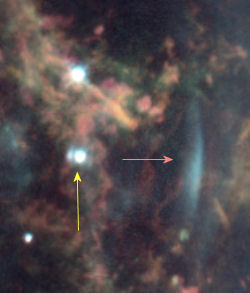 Up close and Personal
Up close and PersonalAt left is a closeup image of the neutron\pulsar star within the Crab nebula; "the core of the star has survived the explosion as a "pulsar," visible in the Hubble image" at left. This is a small section, taken from the original image and enlarged, located at the
HubbleSite-NewsCenter. As noted by the article's author the pulsar star ( yellow arrow ) is heating the surrounding debris field and this, in turn is creating the "ghostly diffuse bluish-green glowing gas cloud in its vicinity, including a blue arc just to its right" ( red arrow ) [ibid]
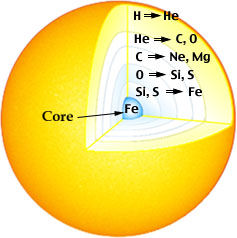 Progenitor
ProgenitorThe Crab's progenitor star (
fn.1 ) was once a supergiant with an interior of onion-like layers fusing ever heavier elements inwards, until an inert iron core developed. "The rapid spin of the Crab Pulsar also created a highly magnetized object, so that the neutron star acts like a gigantic rotating magnet that generates 10 quadrillion volts of electricity (30 million times that of a typical lightning bolt on Earth. Generating the equivalent of 100,000 times the power output of Sol, gradually slows down the pulsar so that its period of rotation is growing by 15 microseconds per year." [10]
 Historical
HistoricalIdentified as the first historical supernova explosion to be recorded, in 1054, the supergiant star exploded with such force that it was seen and recorded by
Chinese and (quite probably)
Anasazi Indian astronomers; so brightly did it appear in the ancient sky that it was said to be as luminous or nearly so, as the moon itself. In the modern sense, the Crab Nebula ( now a supernova remnant ) was first observed in 1731 by the english doctor and astronomer
John Bevis and is the first entry found ( M1 ) in the famous catalog by French astronomer Charles Messier, "
Catalogue des Nébuleuses et des Amas d'Étoiles" or "Catalogue of Nebulae and Star Clusters". "This nebula was christened the "Crab Nebula" on the ground of a drawing (
shown at left ) made by William Parsons ( Lord Rosse ) about 1844. Of the early observers, Messier, Bode and William Herschel correctly remarked that this nebula is not resolvable into stars, but William Herschel thought that it was a stellar system which should be resolvable by larger telescopes. John Herschel and Lord Rosse erroneously thought it is "barely resolvable" into stars. They and others, including Lassell in the 1850s, apparently mistook filamentary structures as indication for resolvability." [11]
DistanceThe distance to the Crab Nebula remains an open question due to uncertainties in every method used to estimate its distance ( currently estimated to be 6.2 to 6.5 kly give or take ). Believed to be about 28—30 km in diameter, it's central neutron star became, in 1967-68, one of the first pulsars to be discovered. In addition, the star emits pulses seen at wavelengths across the entire electromagnetic spectrum, from radio waves to X-rays, and has been observed and imaged with virtually every piece of survey equipment available. Unlike most stellar objects that evolve so slowly over time that no one lives long enough to see change occur, the Crab nebula does so daily and these changes have been visually recorded over a period of years and months. The measured velocity of the Crab nebula is twofold — some areas are redshifted, moving away from us while other areas are blueshifted and moving towards us. [12]
Observations from astronomers and scientists regarding the Crab Nebula and star:"The inner ring is unique," said Professor Jeff Hester of Arizona State University, Tempe, AZ. "It has never been seen before, and it should tell us a lot about how the energy from the pulsar gets into the nebula. It's like finding the transmission lines between the power plant and the light bulb...What is going on, according to Dr. Martin Weisskopf, Chandra Project Scientist from NASA's Marshall Space Flight Center, Huntsville, AL, is awesome. "The Crab pulsar is accelerating particles up to the speed of light and flinging them out into interstellar space at an incredible rate."
From the Chandra X-ray Observatory
"The Crab Nebula still presents mysteries today as the total mass of the nebula and pulsar appears much less than the mass of the original pre-supernova star!"
From the Astronomy Picture of the Day website, July 11, 2000
"The neutron star inside the Crab Nebula may have four magnetic poles, rather than the usual two - unlike any other astronomical object known. The poles may have somehow been frozen into the neutron star when it was formed in a supernova explosion...The observations have revealed other surprises, as well. Because the primary pulse emission lasts just 0.4 nanoseconds, it may arise in an extremely small region just 12 centimetres across, where a cloud of plasma is trapped above the surface of the neutron star."
From Neutron star may sport four magnetic poles by David Shiga, January 2007
The Image Six-Pack from the APOD WebsiteBefore moving on to our next section, let us look at six excellent Crab Nebula images from the Astronomy Picture of the Days website. Clicking on each will bring up information about that particular image in the center box. A link to the APOD site for each image is also provided as most can be viewed there in higher resolution ( recommended ):
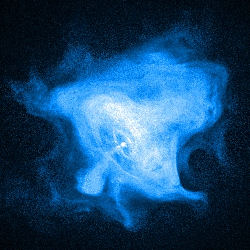


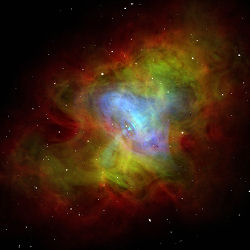


Footnotes
1. The term "Progenitor Star" — the star that birthed the stellar object and as used herein, for the Crab Nebula, the remnant pulsar or Progenitor Star would have been a massive star.
 seconds as a free particle. It and the proton form nearly the entire mass of atomic nuclei and as such, make up most of the mass of the visible matter in the universe.
seconds as a free particle. It and the proton form nearly the entire mass of atomic nuclei and as such, make up most of the mass of the visible matter in the universe. ), 1.98892 x 1030 kg, is a standard way to express mass in astronomy, used to describe the masses of other stars and galaxies. It is equal to the mass of the Sun, about two nonillion kilograms or about 332,950 times the mass of the Earth or 1,048 times the mass of Jupiter. For additional information on soalr mass see Wikipedia
), 1.98892 x 1030 kg, is a standard way to express mass in astronomy, used to describe the masses of other stars and galaxies. It is equal to the mass of the Sun, about two nonillion kilograms or about 332,950 times the mass of the Earth or 1,048 times the mass of Jupiter. For additional information on soalr mass see Wikipedia Fritz Zwicky *
Fritz Zwicky *  Walter Baade *
Walter Baade *  Rudolf Minkowski **
Rudolf Minkowski **  William Parsons
William Parsons 










 The explosive force is the largest known in the universe and as such, the shockwave it creates travels at speeds in excess of 50 million kilometers per hour. At this velocity it slams into and races through the now expanding stellar debris, fusing lighter elements into heavier ones and producing a brilliant visual outburst that can be as intense as the light of several billion Suns. This is a type II supernova and it's caused by the sudden stop and immediate reversal in the process of implosion. What is left — a highly rotating core of dense material called a Neutron Star. Image Credit:
The explosive force is the largest known in the universe and as such, the shockwave it creates travels at speeds in excess of 50 million kilometers per hour. At this velocity it slams into and races through the now expanding stellar debris, fusing lighter elements into heavier ones and producing a brilliant visual outburst that can be as intense as the light of several billion Suns. This is a type II supernova and it's caused by the sudden stop and immediate reversal in the process of implosion. What is left — a highly rotating core of dense material called a Neutron Star. Image Credit: 

 and this is where the process comes to a screeching halt, almost. What has happened up to this point is that all the previous elements that have been ignited have been exhausted, their remains gravtionally compressed towards the core of the star ( remember that a star is held together through the force of it's own gravity ) creating a fantastic amount of pressure upon it, so much so that in some cases enough pressure is built up to ignite even the iron at the core, but this final ignition just speeds up the process of collaspe for, unlike all the other elements, iron 56 requires more engery to fuse than it produces.
and this is where the process comes to a screeching halt, almost. What has happened up to this point is that all the previous elements that have been ignited have been exhausted, their remains gravtionally compressed towards the core of the star ( remember that a star is held together through the force of it's own gravity ) creating a fantastic amount of pressure upon it, so much so that in some cases enough pressure is built up to ignite even the iron at the core, but this final ignition just speeds up the process of collaspe for, unlike all the other elements, iron 56 requires more engery to fuse than it produces.



 The Crab Nebula — Supernova Remnant, Rotating Neutron and Pulsar Star
The Crab Nebula — Supernova Remnant, Rotating Neutron and Pulsar Star
 Up close and Personal
Up close and Personal Progenitor
Progenitor Historical
Historical




